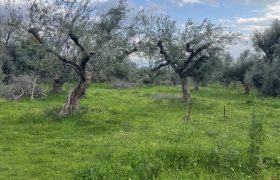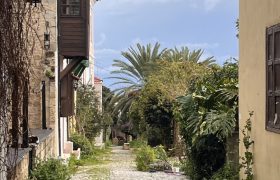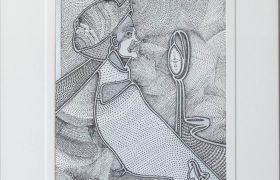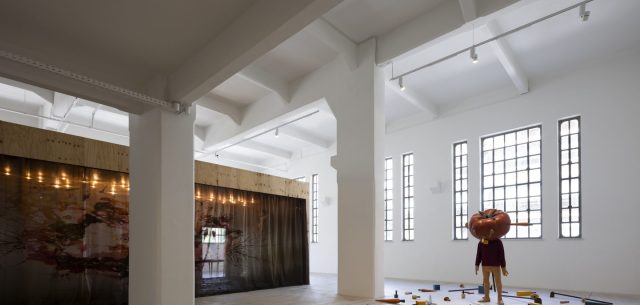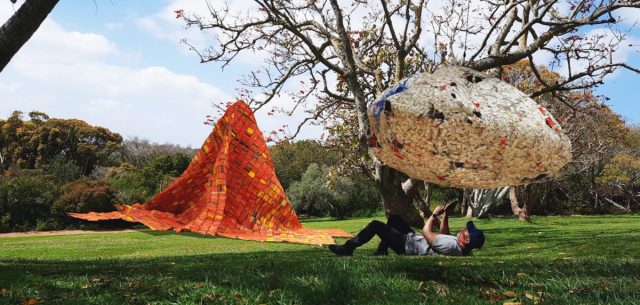Athenography: How does a city that belongs to the past look toward the future?
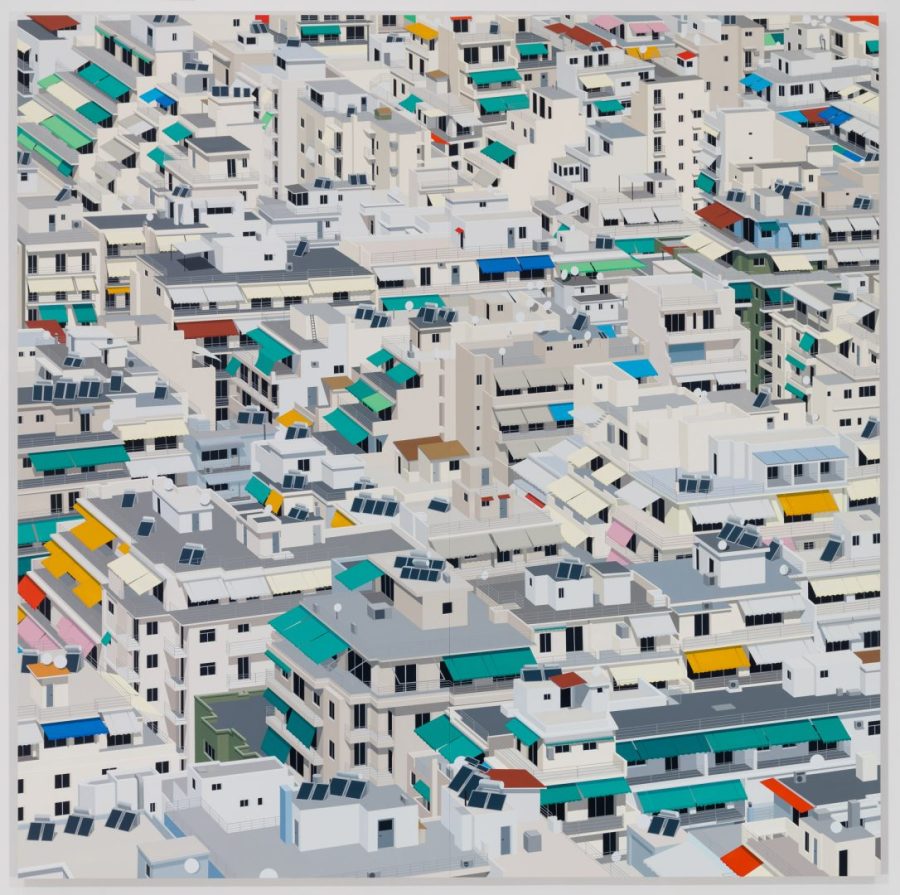
Athens, Daniel Rich, Acrylic on Dibond (2017)
At first sight, Athens may not fit our idea of modernist sobriety in planning and design. But over the last 200 years a remarkably rich understanding has slowly emerged, reconsidering the historical pressures that gave the city its unique rhythms. Anthropologist Tyler Boersen argues that this overdue fascination has made Athens into a paradigm of modernity and is changing the way we see its future.
Travel writers from Pausanias to Henry Miller may have inspired people to visit Athens, but they have actually left us with something more academic in the nature. Whether looking through the 2nd century lens of Athenian cults, or the Baedeker tours of the 20th century, we’re viewing Athens at a particular point of time that guides us around the past like insiders. Scholars sift their accounts looking for raw evidence of how Athens looked and behaved before there were detailed maps, photographs, or indexed archives.
Travel writing is a process of compression that aims to capture experiences, however vast, in a few measly paragraphs. They should leave us with diminutive, efficient observations that easily expand into new journeys in unfamiliar places. But when read together, these spare lines may also give us a sense of vast temporal ruptures between the eras and epochs in which they were written. After all, a good travel writer has first in mind the audience in the world around them, a readership situating themselves in the ideas of Hadrian, Napoleon, even Freud, and all the merchants of empire most relevant to their time. Consider the gaps that emerge between these much-quoted lines:
“I am neither Athenian nor Greek but a citizen of the world.” (Socrates)
“For every city has dedicated a likeness of the emperor Hadrian, and the Athenians have surpassed them in dedicating, behind the temple, the remarkable colossus.” (Pausanias)
“Gone, glimmering through the dream of things that were.” (Byron)
“And like sunrise from the sea, Athens arose.” (Shelley)
“It is still in the throes of birth: it is awkward, confused, clumsy, unsure of itself; it has all the diseases of childhood and some of the melancholy and desolation of adolescence.”(Miller)
“Athens is the new Berlin” (Anonymous)
Sprung from the chest (and often enough, from the crotch) they bring to the surface individual passions and fashionable trends. The city arises obliquely into view, taking up space but hardly observed, quite bigger in the imagination than it could feasibly be in reality.
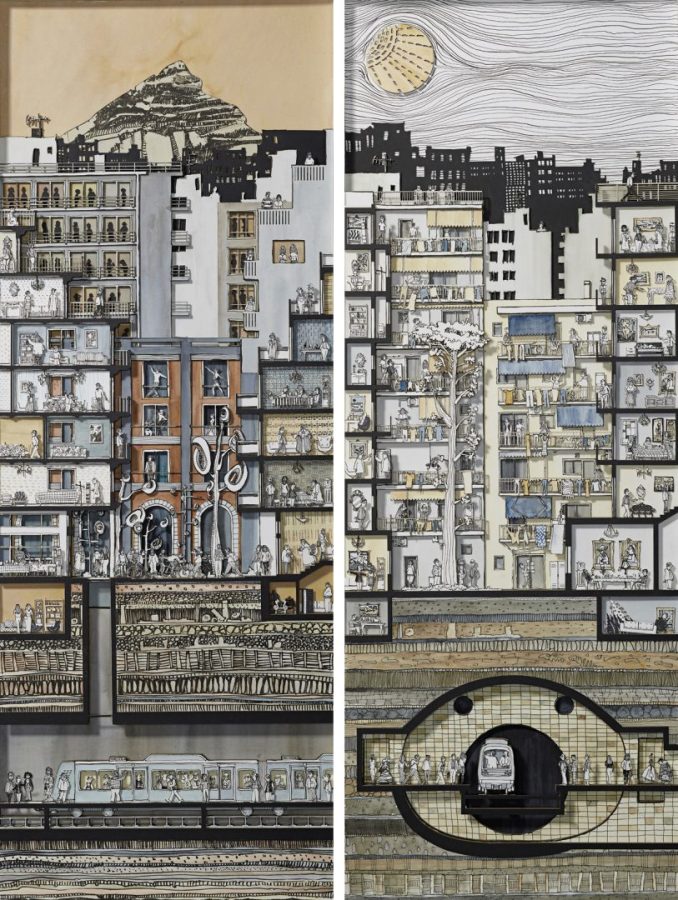
Architect and art illustrator Philippos Photiadis’ Athens
More than a city and its landmarks, the lines of travel writers point toward an expanding sense of self that by the end of the Enlightenment in the early 19th century was corrupted by romantic longing for the past. Travel writers would use their experiences of Athens to refashion the city into a slogan, a reflection of their longing for a perfect community and their own besotted place within it. Such well-drawn images from Byron and Shelley eventually become more vivid than what they depict, and the living Athens has to shoulder its weight.
There is a famous line by the poet George Seferis about waking “with this marble head in my hands; it exhausts my elbow and I don’t know where to put it down.” Seferis skewers that anachronistic longing and the obligations it creates. Could Greeks continue to transport foreigners to the classic period, that time regarded as the most outstanding in history? The travel writers suggest that Athens couldn’t do the job, though Athenians might try.
The word Athenographer ought to be brought to more prominent usage. It may be used for a person who carries that weight while working to lighten the load. They collect various kinds of documents that bear witness to the city at various points of time. They study the records of archaeological findings for signs of the interaction of antiquity with the modern city. They create archives of photographs as well as long lists of objects, both ancient and modern, that connect in a palimpsest of stories.
Since the middle of the nineteenth century, the number of Athenographers has been multiplying and increases today at a rapid pace. This might be a response to the sentiment compressed into the poem of Seferis, which sees the past as a burden.It’s also an effect of the earlier generations, their work now channeled into internet groups. It has become so much easier to access documents and stand on the shoulders of giants.
One of the most outstanding Athenographers, Nikos Vatopoulos, describes it not as a hobby but as a profession, perhaps even a calling. One of the core ideas of Athens has long been that the city is on the edge of being lost. There might be a clue to the city’s story around any corner of the city in a building or an empty plot of land. They are flaneurs, archaeologists, archivists and activists. You might find them digging euphemistically through urban detritus to uncover the city’s secrets, knowing that something has been lost but can be found. For some, it could be like a treasure hunt.
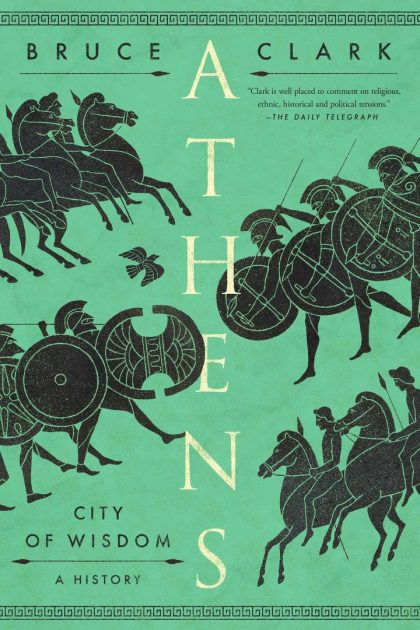
Athens: City of Wisdom by Bruce Clark
Among the many great Athenographers who have been compiling the social history of the city and its transformations since Athens became the capital of Greece in 1834, we could count the singular Dimitris Kampouroglou, the urban planner Kostas Biris, the archaeologist Ioannis Travlos and the prolific writer Giannis Kairofylas. Though little of their work has been translated from Greek into English, it is some of the more pleasurable material to study while learning at an advanced level.
Working in a mode quite different from the travel writers, they expand the field of vision to encompass practically anything thought or produced in/about Athens. Slowly, a long story about Athens has begun to emerge and presented in book length publications, including in English the recent publication of Bruce Clark’s Athens: City of Wisdom.
The city emerges as a global paradigm of a city built during the 20th century with fewer references to antiquity than one would expect from a city carrying such historical weight. Quite to the contrary, Vatopoulos has argued that Athens has been a capital of the twentieth century, with all the architectural periods of the century represented in the styling of the city’s houses and buildings.
Today, Athens may not fit our ideas of severe 20th century modernist sobriety, a city well-tempered that runs on time. But scholars and journalists have begun to pay closer attention, observing how the city that we know today emerged from dust between 1920 and 1980 by following many of its own, mostly unspoken rules. They are mapping the familiar idiom of Athenian apartment buildings, the ubiquitous polykatoikia style that emerged in the 1950s.
An image has started to emerge of Athens not as a city of chaos and contradictions, but a city with a unique rhythm that gives it an identity. Those repetitive shapes suggest common problems. They reveal a shared set of design solutions mostly developed without oversight from institutions of order, and largely without interventions by architect and planning offices.
This new attention has brought overdue fascination and cautious respect to the polykatoikia as a living repertoire of Athenian building design. These rhythms are today becoming recognizable in contemporary art and tourist souvenirs, and they have restored interest in the functionality and adaptation of existing houses and old warehouses. Most of the new hotels and offices in Athens are done by retrofitting existing polykatoikies and their office cousins. Even Vatopoulos, a lover of all the quaint corners of the city, has written that there will be a time in the future when we look back at polykatoikies with nostalgia as they are being replaced.
Athens may feel like a contradiction because locals and visitors are insistently asked how to connect past to future. But slowly the city is emerging not as a mistake, but as a culmination of historical pressures that we’ve been living with during the last two hundred years that have materialized as a city of concrete. Scholars have also been mapping similar housing solutions in global cities around the world, many of which emerged during the same period of urbanization when millions of people were migrating from farm to city after World War II.
A series of articles in Bloomberg Cities examined the “iconic home designs that shaped global cities,” many of which emerged at the mid-century. The Athenian polykatoikia stood out as an “accidentally” resilient design, a response to urgent needs during a desperate era that stands up remarkably well as a solution to the urgent needs of today to cut carbon emissions while maintaining inclusive housing and neighborhoods.
Perhaps that quiet recognition of Athens as a long-time laboratory for design has helped make it trendy to be occupied as an Athenographer tracking the city’s rhythms. In the coming years we are likely to see the growing impact of these studies in the restoration and design of more homes, hotels and restaurants. Facebook is full of pictures of polykatoikias of various styles and ingenuous inventions, giving respect even to afthaireta that was once ominously described as arbitrary, primitive and illegal.
This movement toward Athenography has the potential to radically alter our sense of what Athens will become in the future as locals and visitors learn more about the city and its history, and as the city’s rhythms become more distinct, emphasized, and more easily preserved. Rather than the compressions of travel writers that have become so familiar, today we have shelves lined with books about Athens, we have mid-century Athenian ceramics that were once thrown to the trash but are suddenly valuable collectible. More people are heading to the city’s vast flea markets looking for Athenian objects to salvage before they completely disappear.
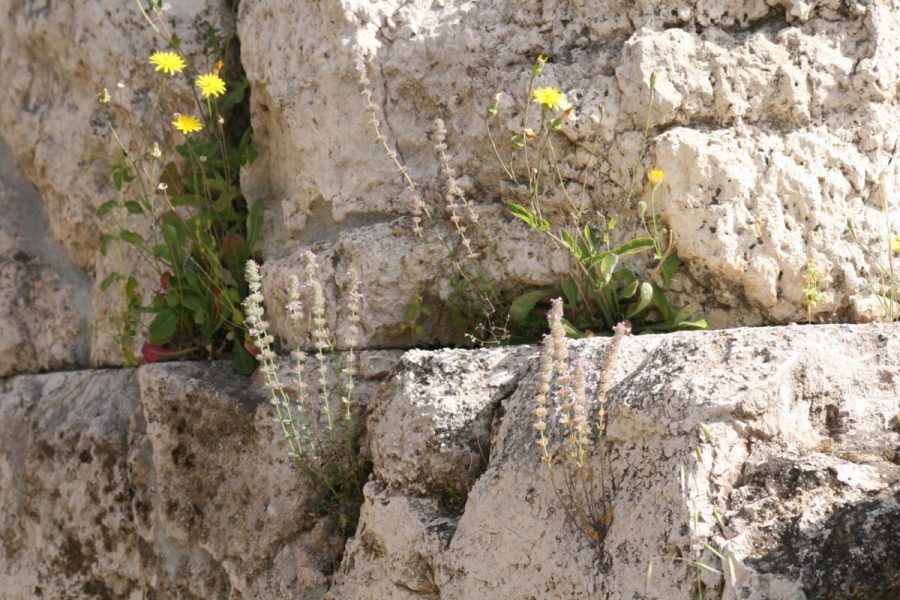
Micromeria of the Acropolis (Micromeria acropolitana). From the book “On the paths of the Acropolis” (photo: Grigoris and Lampros Tsounis).
Two recent books add new and valuable dimensions to this new period of Athenography and show the power of this decompressing the language for Athens to change our perceptions of urban time. The first draws attention to the overlooked biological system at the city’s and the world’s most famous monument, including plant and animal life that could easily be wiped away after millions of years by a brief period of human activity. The second points to the slow grind of deliberative processes to prevent a momentary decision that might erase overlooked cultural heritage.
On the Paths of the Acropolis (Στα Μονοπάτια της Ακρόπολης) by Grigoris and Lambros Tsounis and published by Kedros Press goes beyond the familiar idea of the Acropolis as a monument of global culture. The father and son biologists argue that the Acropolis is a monument of nature where more than 300 kinds of plants are living today. Rethinking the rock as a singular global habitat gives us a new sense of why it has long been regarded as holy.
The Acropolis continues to be a rare habitat in spite of two centuries of excavations that have peeled off its layers of built structure to restore the classical era layout of the site. Two millennia of accumulated surface material have been stored in warehouses, discarded, or assembled into spiritless piles of rock. The micro-ecosystem of the Acropolis and surrounding hills was repeatedly and violently disrupted, if not entirely destroyed.
Hope has not been lost. One very small plant with red blossoms that exists nowhere in the world except for the Acropolis, Micromeria acropolitana, was last recorded and published in 1908 and was thought to have gone extinct. Grigoris and Lambros identified a very small population of the plant in 2006, and today those small colonies are protected sites alongside the more familiar marble monuments. This tiny flower should provoke wonder to rival the Parthenon as a representation of the biodiversity that emerged long before humans were on the planet, let alone the Acropolis.
With this in mind, now we can view Athens through a much longer, extended window of time than that which usually comes to mind. No doubt we can see the geological history of central Athens in a few places where we still see the marled schist that projects from between the buildings, helping to imagine the landscape before the construction of the city. Thinking about the resilience of plant and animal life on the Acropolis – the losses and surprising resurrection – should make us see Athens as part of a planetary history that persists against our more frequently told human histories.
Today we know that we ignore that planetary history at our peril, but it might take a reimaging of the Acropolis and Athens in order to truly understand what is at stake and the new mentality required. Set aside the Acropolis as a monument of the Enlightenment and all those travel writers inspired by the Enlightenment and nourished on interpretations of events that happened only 2500 years ago. We should say that we cannot define the Acropolis without those tiny red flowers. It cannot exist without them. They are a vibrant response to the Acropolis in all its specificity, and after all, they and could not exist without it.
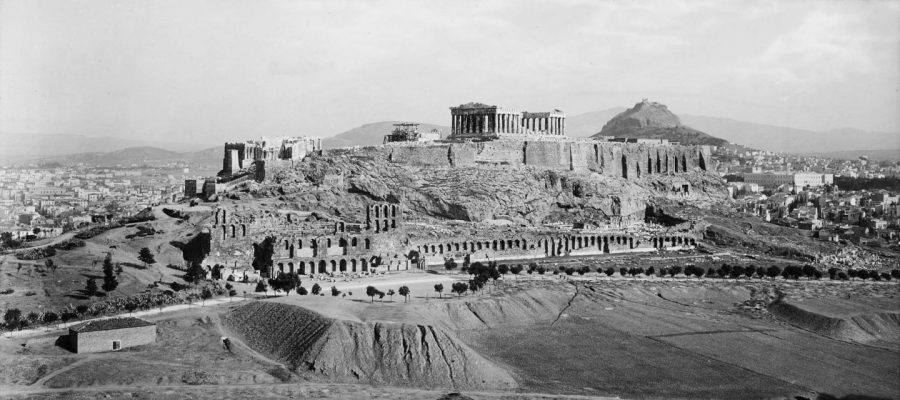
Photograph of Athens by British photographer Alexander Lamont Henderson, 1904
There’s a surprisingly similar group of arguments in the recent book The Future of Plaka (Το Μέλλον της Πλάκας) by Alexandros Papageorgiou-Venetas and published by Kapon Editions. The book is a collection of transcripts from a meeting organized at the City Hall of Athens in 1966 with the participation of architects, planners, politicians and neighborhood advocates.
The first city plans in the 1830s had called for an extended archaeological zone stretching fully around the Acropolis, including much of what today we call Plaka. The private ownership of the land and buildings had been in limbo for decades and always under threat of expropriation. Without the incentive to repair aging structures, the area had been taken over for nightlife.
The book is a valuable window into the diverse thinking about cultural heritage that was already in place in the 1960s. Was Plaka a living neighborhood? Was it ancient? Was its creation an accident? Was it a working class district in need of preservation? Was it valuable for what lies underneath, or worse, as a passageway for roads?
We are coming back into view of the travel writers who imagined a city for the Enlightenment, indeed a paradigm of historical preservation and a center for the study of global art history. The archaeologist Ioannis Travlos (whose pictorial guide to the classical archaeology of Athens was published in English and is indispensable) represents the view that whatever is found would likely be so significant to the story of humanity that it justified the destruction of the old city. He argues for expropriation by the state with a view to future excavation.
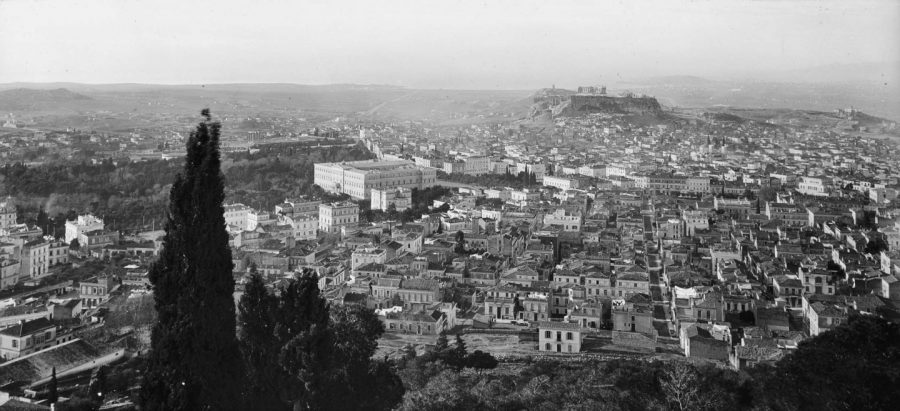
Photograph of Athens by British photographer Alexander Lamont Henderson, 1904
In contrast, Nikolaos Psarras of the residents’ association of Rizokastros (the neighorhood at the “roots” of the Acropolis) pointed out that the resurrection of classical heritage was meant to secure the idea of the nation, which he argued was a novelty under development for barely two centuries. Plaka was a rare example of the continuity between Hellas of 2500 years ago and the nation presented as modern Greece, and for that reason should be preserved.
Ultimately this attempt to salvage national heritage would win the day. Plaka was increasingly viewed as emblematic of tradition, itself becoming evidence of the passing of time and the creation of the modern city itself.
A few steps higher up the hill, the famous Anafiotika neighborhood was also long considered by authorities as an uncomfortable contradiction of the Acropolis above (or something more vulgar, an intrusion). Anthropologist Roxane Caftanzoglou has described a confrontation between the antiquity of Athens as a debt to global humanism and what she describes as “small histories,” not only the tiny neighborhood of Anafiotika with its 50 houses but the stories of individual families who had made the life of the neighborhood into a decades-long project. The national narrative saved the appearance of the neighborhood, but not its way of life, because it would be finally expropriated and preserved as a frozen museum.
Today, visitors come to Athens to be reminded of the global history of humanity collected in museums. Increasingly they stay to participate in the creation of many small design projects that replicate across the city like a miraculous rhythm, which leaves a feeling that the city runs up to the edges of our perception a bit like an abstract expressionist painting rather than a city of contradictions or a vacation hotspot. Increasingly, and with urgency, we see this city extending beyond our human limits, and we look for new ways to observe, organize, and collect the objects and ideas that it produces. That’s the spirit of Athenography.


